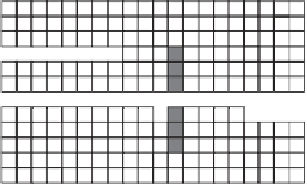Global Positioning System Reference
In-Depth Information
ance predicted by (9.1), suitable search ranges can be determined about the pre-
dicted code phase. Often, the search region is selected as
3 sigma
, corresponding to
±
σ
cp
. This ensures a high probability (roughly 99% under a jointly Gaussian
assumption for the probability distribution) that the signal is within the selected
search region. Figure 9.3 illustrates the two-dimensional nature of the search region
for a full code phase search. Prepositioning, as just described, offers the potential for
drastically reducing the search space by collapsing both dimensions. If the number
of cells remaining (i.e., subsets of the two-dimensional search region one-half chip
by the chosen Doppler bin size) are less than or equal to the available number of
receiver correlators, then parallel searching can be performed to reacquire the sig-
nal. This technique can also be used for initial acquisition of the GPS signals using
an INS that has been calibrated by other means.
As mentioned earlier in this section, the use of INS velocity outputs, corrected
by the Kalman filter, can be used to extend signal tracking in adverse signal condi-
tions. Fundamentally, any tracking loop performs three functions: attenuation of
the noise in the observables that are passed to the Kalman filter; tracking of the
dynamics of the host vehicle in which the receiver is installed; and, finally, tracking
of the dynamics of the receiver's oscillator. Use of INS aiding effectively removes the
second requirement, enabling significant reduction of the tracking loop
bandwidths, thus enabling tracking at lower SNRs. It is, in general, the requirement
to track the dynamics of the receiver's oscillator that sets a floor on the bandwidth
reduction and track extension. As discussed in Section 9.2.4, tracking loop aiding
can be performed for both code and carrier tracking. The ability to extend code
track can exceed 25 dB.
An area of concern in the use of GPS, especially in commercial aircraft applica-
tions, is integrity (see Section 7.5). An anomalous GPS satellite signal most likely will
result in the calculation of an erroneous position. The use of inertial components
allows the GPS pseudorange measurement to be compared against statistical limits
(typically 6-sigma deviation) and rejection of those measurements that are beyond
the limits. The components of the INS (i.e., gyros and accelerometers) can fail as
well. Historically, the use of redundant INS or gyros and accelerometers has been
3
Chip = (R/c(.001/1023)) MOD 1023 +U
R
R = slant range
c = speed of light
U
= uncertainty
R
1023 Chips
Frequency = L (c+v
)/(c-v )
x
kv
sv
L = GPS frequency
x
v
= slant velocity of vehicle
kv
v
= slant velocity of SV
sv
Frequency bins
Figure 9.3
Aiding supports the acquisition/reacquisition process.










Search WWH ::

Custom Search